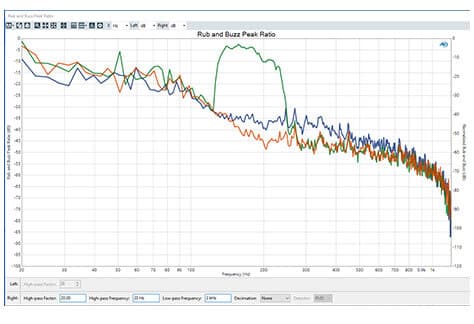Audio Precision has released the latest update to its APx500 audio measurement software, which allows production testing of loudspeakers, headphone drivers and microphones. Version 6.1 adds new measurement results, options and test signals, in particular a new set of methodologies for detecting rub and buzz defects.
The most common defect categories in speaker manufacturing are rub, buzz, and air leaks, explained Audio Precision. Rub-related noises occur when the speaker cone is off-center or canted and thus mechanically rubs when it moves to create sound. Buzz defects occur when loose particulate matter, such as chipped magnet material or bits of glue, are trapped in the gap between the speaker’s voice coil and the cone. Air leaks are commonly perforations in the speaker surround, imperfectly sealed dust caps or other unintentional gaps in the housing or cabinet.
With rub and buzz defects, the imperfections in a speaker that can negatively impact a listener’s perception of the speaker’s quality, but those defects are not necessarily detectable by traditional audio measurements, said audio testing company. The latest version of APx500 software offers several rub & buzz defect detection methodologies for speaker designers and manufacturers:
- Rub & Buzz uses high-pass tracking filters to remove the fundamental signal and detect defects as excursions in the residual waveform’s crest factor or peak ratio. This method was in the earlier version of the software.
- SoneTrac (new with v6.1) is a Bose-developed improvement to Rub & Buzz. This method filters the residual signal and ratios it to the RMS of the total signal to reduce the noisiness of the measurement result.
- High-Order Harmonic Distortion (new) is a classic method for rub & buzz detection. HOHD uses the Total Harmonic Distortion ratio, but only of harmonics above the 10th, 10–35, 20–200, etc., which is a simple way to account for frequency masking effects.
- Rub & Buzz Loudness (new) applies a psycho-acoustic loudness model to the residual signal to calculate the perceived level of the rub and buzz based on well-established models of the human perception of sound.
To support the addition of the HOHD and Rub & Buzz Loudness measurements, the new software version is also introducing Fast Sweep. Fast Sweep is an extremely fast stepped frequency sweep with no input or output ranging between steps. A few of the advantages of the Fast Sweep, notes the company, are the lack of transient ripples at low or high frequencies, the ability to sweep from low-to-high or high-to-low frequency, the support for measuring harmonics above the 20th, and the precise control of the number of discrete points used in measurements.
Additionally, APx500 v6.1 now allows users to switch instantly between IEC and IEEE THD calculation modes for harmonic distortion results. It also adds the ability to normalize harmonic distortion results, addressing common measurement artifacts that occur when testing loudspeakers. Users can save all acquired waveform, impulse response or cross-correlations results to .wav files, and this function can be included as a sequence step in automated measurement sequences, according to Audio Precision.
“While version 6.1 is officially a minor release, and thus a free upgrade to any analyzer licensed for version 6.0, it delivers significant, new capabilities, especially for those involved in the design, manufacture, and test of speaker drivers and any product incorporating them,” said Daniel Knighten, Audio Precision’s GM.
New APx audio analyzers are now shipping version 6.1 software. The new release is compatible with all analyzers in the APx500 Series. Users can download the latest version from Audio Precision’s website.

